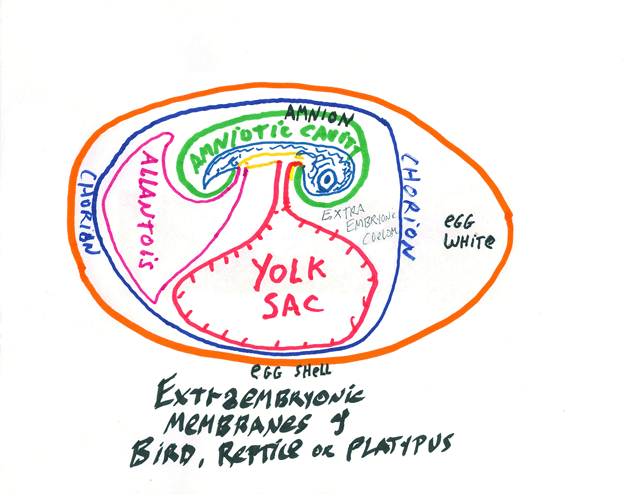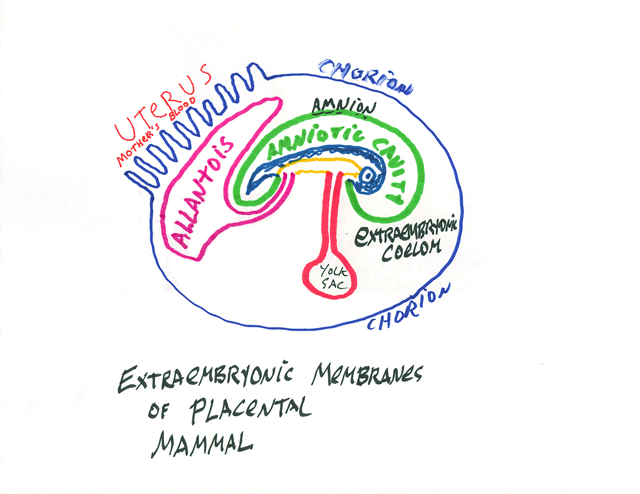Extraembryonic Membranes
Developing embryos of reptiles, birds and mammals have four extraembryonic membranes, and these are parts of the placenta of developing mammals.


* The Chorion: part ectoderm and part lateral plate mesoderm;
extends around the whole of the embryo, protects it and keeps it wet.
** The Amnion: part ectoderm and part lateral plate mesoderm: Surrounds the developing body, and is colloquially called "The Bag Of Waters"
*** The Yolk Sac: part endoderm and part lateral plate mesoderm: Provides nutrition, and surrounds the yolk, except in mammals. It becomes a side branch of the small intestine.
**** The Allantois: part endoderm and part lateral plate mesoderm; Stores urine; its blood vessels are the main vessels of the placenta, and it develops as a side branch of the bladder.
The Umbilical Cord connects the body to the extrambryonic membranes. (all of which are really organs, please notice, not just membranes.
Turtles, snakes etc. also have belly-buttons, incidentally, where their bodies were connected to their extra-embryonic membranes!
Many snakes are live-bearing: that means that the embryos develop inside the body of the mother snake. Copperheads are one of many examples.
No one knows much about the evolutionary steps leading to the chorion, amnion,etc. In particular, were the intermediate species egg-layers or live-bearers? Either is conceivable. There could have been intermediate versions of external eggs in which out-folded epithelial layers gradually surrounded the developing body, more and more completely (culminating in the evolution of the amnion and chorion). Alternatively, these structures could have gradually evolved in live-bearing intermediates between amphibians and reptiles. I don't know what kind of evidence we should look for, either in fossils or in genomes, that could prove or disprove either possibility. A closely related question is whether egg-white and egg shells evolved before or after the chorion, the amnions, and the allantois. I presume that the yolk sac evolved before all of them.
But I would value your opinion on these issues, and about what kind of evidence should be looked for.
About half of human identical twins result from formation of two inner cell masses inside the same blastocyst. This mode of twin formation is deduced when twins share the same chorion, but each has its own separate amniotic cavity. Most of the rest have separate chorions as well as separate amniotic cavities.
The third, and rarest, cause of human identical twins
is formation of two primitive streaks on the same inner cell mass.
This can be deduced after the fact by the twins being inside
the same amniotic cavity (bag of waters).
Only for this third form of twinning is there danger (possibility) that some parts of the twin's anatomy will be part of both their bodies (conjoined twins = so-called "Siamese twins").
Only a small minority of twins formed this way are conjoined; but none of the identical twins formed in the other two ways are ever conjoined.
Although it is not wrong to say that their bodies are fused, you should not think that separate bodies formed, and then somehow merged. What really happens is that the same mass of cells gets subdivided into the organs of two bodies (as if you were molding two pots from the same piece of clay, would be a possible analogy. I would appreciate being e-mailed any better analogy you can think of.)
For those of you who now love the subject of symmetry, notice that conjoined twins are (nearly?) always mirror images of each other (at least, of those that survive).
This must be telling us some important facts about the normal control mechanisms of body formation. (but nobody knows, or notices).
These are some of the reasons why it is misguided for politicians or news-writers to argue that there is some certain time when an embryo becomes alive. That is about on the level of old Frankenstein movies. Are we going to claim embryos are two people until the latest stage when twinning could occur? And then what? A serious question is: when does a developing embryo develop far enough to have a functioning nervous system, and thus be a person. Sperm are alive; oocytes are alive; they remain alive before and after the second meiotic division, before and after cleavages, compaction, implantation, inner cell mass formation, primitive streak formation, before during and after gastrulation and neurulation.
If somebody knows enough to have an opinion about why conjoined twins are mirror images of each other, then that person gets to have opinions about exactly when life begins. Otherwise, they should try to learn, not be dogmatic.
Incidentally, even when not conjoined, twins formed from the same inner cell mass are (usually? always?) mirror images of each other. The twin on the right has a heart & intestines with reversed symmetry. The twin on the left is dominant.
I don't see how to explain this by beating of flagella at Hensen's node. I would be grateful for suggestions about this.
______________________________________________________
Please remember that
*we mammals evolved from egg-laying reptiles,
** three species of mammals remain that still lay eggs,
which are very much like reptile and bird eggs.
(One species of Platypus and two species of Echidnas, in Australia and New Guinea)
Because even Echidnas are so rare and endangered, there has not been much study of their embryology.
Marsupials, like Opossums and Kangaroos have oocytes that are much smaller & less yolky than birds and platypuses, but much larger and more yolky than regular mammals, like us. I think they are an evolutionary side branch & would like to learn more about their embryology, about which there have been many studies. But we have to skip them in this course.
Gastrulation, neurulation and later development are almost the same in regular ("eutherian") mammals as in birds.
